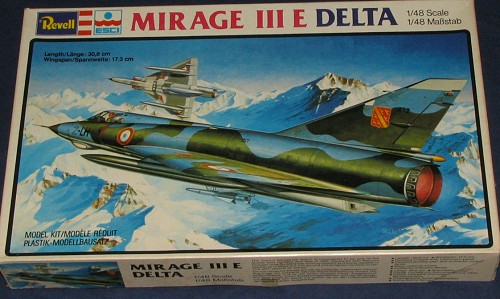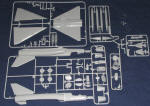
| KIT: | Revell/ESCI 1/48 Mirage IIIE |
| KIT #: | H-2283 |
| PRICE: | $? |
| DECALS: | Four options |
| REVIEWER: | Scott Van Aken |
| NOTES: | Bought for $5 and missing decals |

| HISTORY |
While the Mirage IIIC was being put into production, Dassault was also considering a multirole/strike variant of the aircraft, which eventually materialized as the Mirage IIIE. The first of three prototypes flew on 1 April 1961.
The Mirage IIIE differed from the IIIC interceptor most obviously in having a 300 mm (11.8 in) forward fuselage extension to increase the size of the avionics bay behind the cockpit. The stretch also helped increase fuel capacity, as the Mirage IIIC had marginal range and improvements were needed. The stretch was small and hard to notice, but the clue is that the bottom edge of the canopy on a Mirage IIIE ends directly above the top lip of the air intake, while on the IIIC it ends visibly back of the lip.
Many Mirage IIIE variants were also fitted with a Marconi continuous-wave Doppler navigation radar radome on the bottom of the fuselage, under the cockpit. However, while no IIICs had this feature, it was not universal on all variants of the IIIE. A similar inconsistent variation in Mirage fighter versions was the presence or absence of an HF antenna that was fitted as a forward extension to the vertical tailplane. On some Mirages, the leading edge of the tailplane was a straight line, while on those with the HF antenna the leading edge had a sloping extension forward. The extension appears to have been generally standard on production Mirage IIIAs and Mirage IIICs, but only appeared in some of the export versions of the Mirage IIIE.
The IIIE featured Thompson-CSF Cyrano II dual mode air / ground radar; a radar warning receiver (RWR) system with the antennas mounted in the vertical tailplane; and an Atar 09C engine, with a petal-style variable exhaust.
The first production Mirage IIIE was delivered to the AdA in January 1964, and a total of 192 were eventually delivered to that service.
Total production of the Mirage IIIE, including exports, was substantially larger than that of the Mirage IIIC, including exports, totaling 523 aircraft. In the mid-1960s one Mirage IIIE was fitted with the improved SNECMA Atar 09K-6 turbojet for trials, and given the confusing designation of Mirage IIIC2. Most Mirage IIIE aircraft are now gone from the world's air forces though some are still plying the skies from time to time after having undergone various upgrades.
| THE KIT |
 One
of the things that ESCI produced was a very nice Mirage IIIE. Now some will
claim that the kit has shape problems, but since I'm not a plans person, I
can only say that when you get finished with the kit, you have a very nice
model that looks quite like what it is supposed to be. ESCI produced this
kit in a number of different boxings, each with different decals and at
times, with different parts. This particular Revell Boxing seems to be the
standard version, kit # 4030.
One
of the things that ESCI produced was a very nice Mirage IIIE. Now some will
claim that the kit has shape problems, but since I'm not a plans person, I
can only say that when you get finished with the kit, you have a very nice
model that looks quite like what it is supposed to be. ESCI produced this
kit in a number of different boxings, each with different decals and at
times, with different parts. This particular Revell Boxing seems to be the
standard version, kit # 4030.
Molded in grey plastic with finely done raised panel lines, this particular boxing is free of flash and though it does suffer a bit from ejector pin marks, most of them seem easily removed. There is detail in the wheel wells and inner gear doors though this is a bit thick and so you'll find large sink areas on the outside of the main gear outer doors. I also found some rather hefty sink areas opposite ejector towers in the fuselage nose area.
The interior consists of a cockpit tub, rather generic looking seat and control column. The instrument panel and consoles are smooth and the instruments represented by decals, which makes for a poser in this decal-less kit! Wings have the control surfaces molded in the top half making for a sharp trailing edge. The leading edge of the upper wings show large sink areas that will need filled. The elevon actuators are separate as are the various fuselage scoops. The exhaust is only really as deep as the afterburner petals so you may want to drill this out, insert some tubing and engine detail. Two high speed drop tanks are provided for the wing pylons and the central pylon contains a Matra missile.
Instructions are well done and provide good construction steps and generic paint colors. If I had decals, I'd find markings for four aircraft; one from France, Switzerland, Australia and Spain. Fortunately, there are aftermarket sheet around for this kit so all is not lost.
| CONCLUSIONS |
I built this same basic kit in the ESCI box many years ago and found it to be a trouble-free build. It isn't as detailed as a modern kit but when it is done, it will add another interesting model to your collection. Though there have been rumors of a modern quality Mirage IIIE on the horizon (and perhaps Eduard will do one), that kit has not seen the light of day . This one is very much worth seeking.
December 2005
If you would like your product reviewed fairly and fairly quickly by a site that has nearly 300,000 visitors a month, please contact me or see other details in the Note to Contributors.